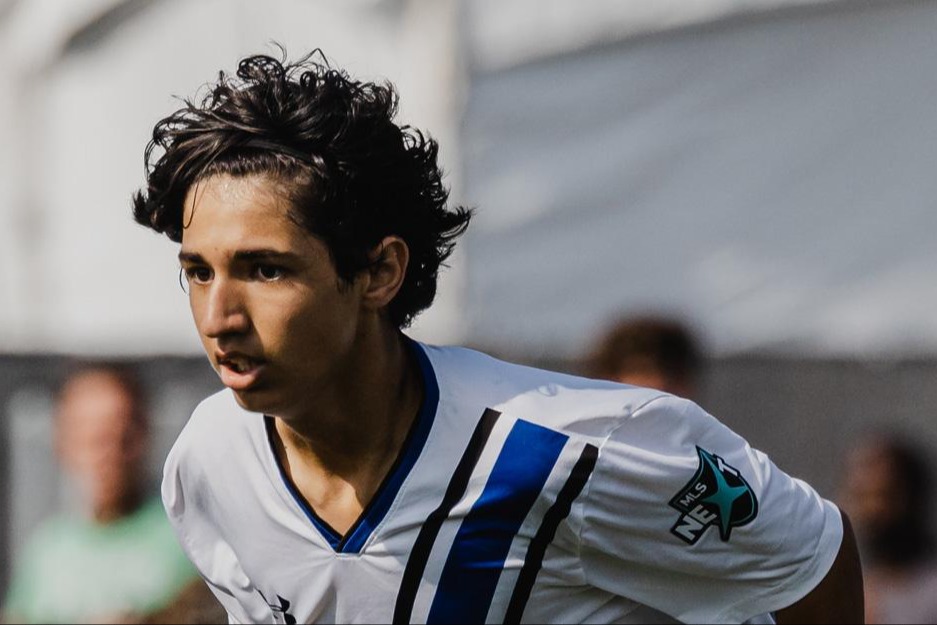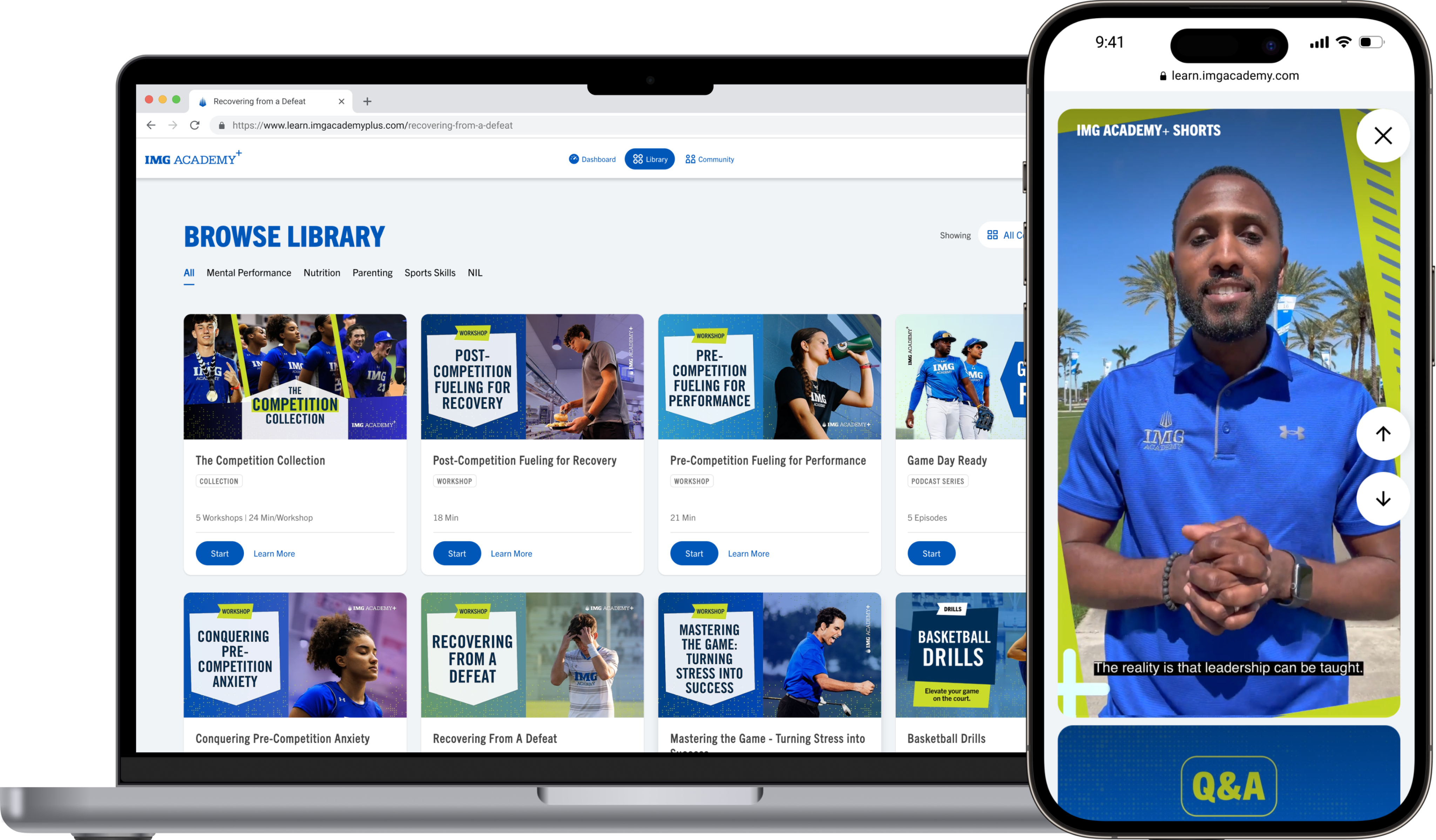How to Stay Focused: A Guide for Student-Athletes

Telling student-athletes in their early teens to keep their heads in the game for the full 90 minutes of a typical soccer match is a big ask.
Especially when you consider that even adults, with theoretically longer attention spans, sometimes struggle to focus on a 20-minute speech or just an eight-minute podcast.
So Maddie Petry, a Senior Mental Performance Coach at IMG Academy, starts small.
“One of the concepts that I work with student-athletes on is separating time into chunks,” says Petry, who specializes in girls’ soccer. “Obviously, sustaining their focus for the entire 90 minutes of the game is still the goal, but learning to spot the opportunities for ebb and flow of really centralized focus — where they are committing every ounce of energy to the task at hand — can help them to build that.”
When an attacker’s ball swoops into a player’s defensive zone, “we obviously want the player totally locked in,” she says. “But when the ball is on the other side of the pitch, they might be able to step out of hyperfocus mode.”
Unlocking the Ability to Build Focus
Building sustained focus that can last through a full game starts with helping student-athletes to consciously identify where their focus is, Petry explains. From there, they can begin to direct their attention as they choose for progressively longer periods, learning to recognize potential distractions and tune them out.
Petry typically starts the process with incoming classes by teaching the athletes to differentiate between an internal focus, where the brain can bounce from one topic to another at will, and a narrower external focus in which the brain must concentrate on executing a particular skill set.
It can be a tricky concept for younger students, since it’s highly abstract rather than tangible.
Still, “self-awareness is really key to being able to unlock where we’re trying to go, whether that’s with athletic performance goals or with our focus,” Petry says. Once student-athletes grasp it, they can begin tracking what they’re focusing on and identifying distractions.
In breathing exercises, for example, they can analyze when they stopped counting their breaths and why, whether it was because of intrusive mind chatter or restless fidgeting.
“A lot of my work focuses on teaching them to understand where they are in their current environment, whether that’s helping or hurting their performance, and then making adjustments as needed,” Petry says.
Much of the work that student-athletes do is centered on the present moment. And honing the ability to focus on that moment is one of IMG Academy’s five pillars for optimal mental performance.
“Whether it’s for an individual or a team, being able to determine whether you’re starting out strong for the first 10 minutes and then tanking, or if external factors are getting in the way, enables us to start working on a solution,” Petry says. “We can problem-solve together.”
Mistakes may be unavoidable in any game, but learning to control their responses to them can help athletes minimize their impact.
“Rather than asking yourself, ‘Why is this happening? Why am I doing this incorrectly? Why is this still a problem for me?’ it’s better to ask questions like, ‘How can I get better at this next time?’ and ‘How can I improve that move?’” Petry says. “By doing that, you’re switching your focus back to something you can control rather than diving into an unproductive thought process. You may really want to get to that answer, but it’s not helpful for your attention to go down that rabbit hole, given the environment in a game scenario.”
Accepting the Rip Current of Thoughts and Feelings
Sometimes, when student-athletes experience uncomfortable emotions such as disappointment, anger with themselves, or fear, they want to push back against those feelings or control them.
Doing so can be distracting. Instead, it’s often helpful to simply acknowledge and accept them while staying focused on the task at hand.
Petry compares the situation to being caught in a rip current while swimming near the shore. Inexperienced swimmers may wear themselves out unsuccessfully fighting the current to swim directly back to safety. A more effective response is swimming parallel to the coastline until they escape the current and then returning to land.
“When we fight against something, it tends to get messier, and we get exhausted,” Petry says. “Sometimes we just need to sit with a feeling and understand where it’s coming from so that we’re able to choose an action that gets us closer to the desired result or in a productive headspace.”
Is It Helping or Hurting?
The question isn’t whether feelings and thoughts are good or bad, right or wrong, but whether student-athletes are focusing on them at an inopportune time, Petry adds.
“Is what you’re thinking or feeling where your focus is right now, and is that helping or hurting you?” she asks student-athletes. “Then we go from there. If it’s hurting you, we work on changing where your focus is.”
It’s not uncommon for student-athletes to equate acceptance with the positive-thinking mantras of pop culture, believing that they’re being told to rejoice in their frustration, she says.
That’s not the goal.
“Acceptance isn’t saying, ‘Wow, I’m frustrated, and that’s awesome’ or ‘I’m thrilled that I’m frustrated,’” she says. “It’s saying, ‘OK, I’m frustrated, that sucks, and I wonder what I could do about it rather than identifying with it more strongly.”
For student-athletes, considering how they might be able to improve the frustrating situation shifts their focus back to things that are within their control, Petry explains. “It can be such a simple question, but in moments of chaos or stress, we often forget how much control we actually have over the situation because things feel like they’re happening to us. Acceptance flips the lens a little, putting our student-athletes back into the driver’s seat of their experience, even in the presence of their uncomfortable feelings or thoughts.”
Once student-athletes learn to control their focus, she says, growing — and even maintaining — the ability requires constant practice.
“An athlete may have thousands and thousands of reps with their ball or their stick, but that doesn’t mean they stop drilling,” Petry explains. “Any mental performance skill is the same.”
Ready to learn how you can perform in the clutch? Take IMG Academy's on-demand course on Focus, exclusively included with an IMG Academy+ Essentials membership.
Don't miss out on more resources. Explore IMG Academy+ Essentials.
IMG Academy+ Essentials
